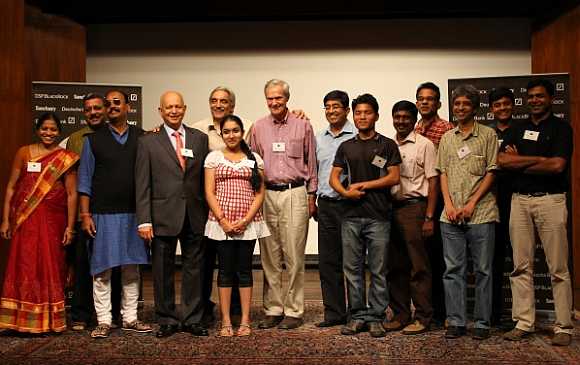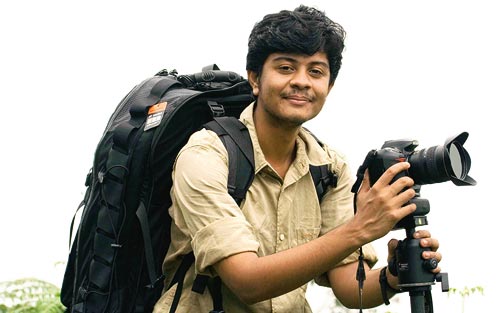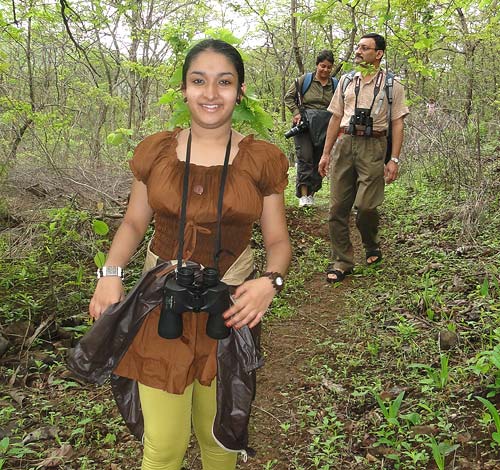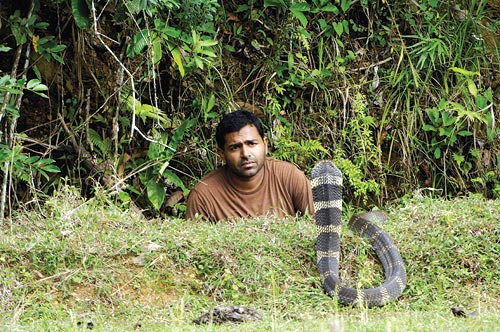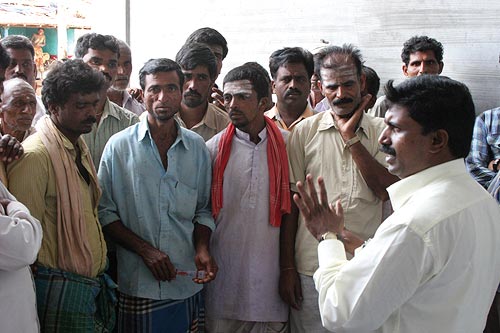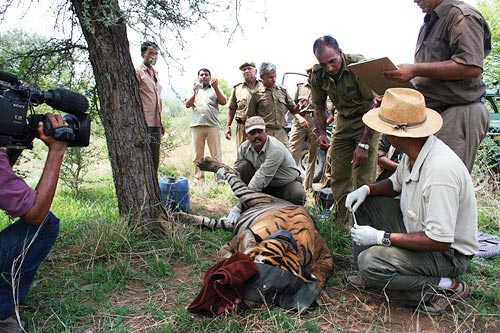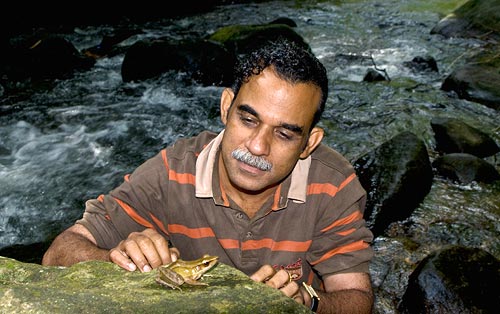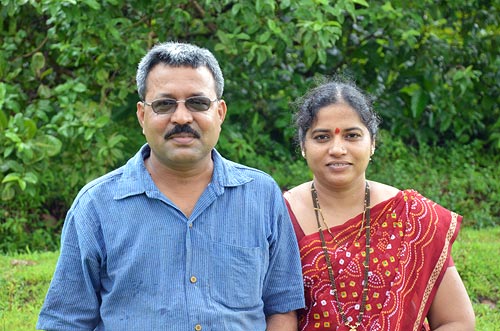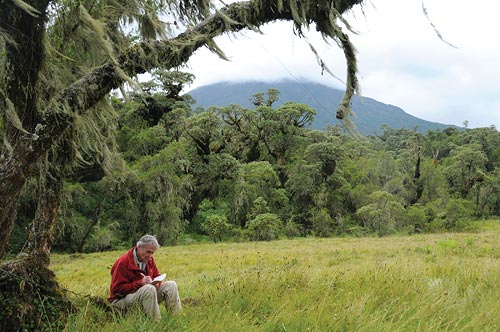 | « Back to article | Print this article |
Photos: These Indians are saving Planet Earth
Bittu Sahgal, Editor, Sanctuary Asia announced the 12th Sanctuary Wildlife Awards, 2011, in Mumbai. Here's the list of the awardees and why they were honoured.
The motley group -- India's Earth Heroes -- comprised a scientist who has walked with snow leopards and giant pandas, an earth hero who has survived an attack by a tiger, a field biologist who walks, talks and studies frogs and an administrator whose heart beats for wildlife. These are just some of the fascinating people being honoured at the 12th Sanctuary Wildlife Awards, 2011, supported by DSP BlackRock and Deutsche Bank.
While Dr George Beals Schaller, was conferred with the Lifetime Service Award, Wildlife Service Awards were given to Sathyabhama Das Biju, Shekar Dattatri, Gerard Martin and Daulat Singh Shaktawat, P Suresha.
The Young Naturalist Awards were conferred upon Ramnath Chandrashekar, Aishwarya Sridhar and Tengbat Sangma.
As a special category the state government of Maharashtra was given the Wind Under The Wings Award for enabling and encouraging wildlife conservation in the state.
Rajendra and Pournima Kerkar, educators, conservationists and social workers were bestowed with the Green Teacher Award.
Here's more on what each of these Earth Heroes do to deserve the awards, beginning with the young in the list of awardees.
Photographs Courtesy: Sanctuary Asia
Photos: These Indians are saving Planet Earth
Ramnath Chandrashekar
Award-winning wildlife photographer and conservationist
At 22, Ramnath Chandrashekar has already chalked up an impressive list of achievements. Quite apart from being an accomplished nature photographer, he has an abiding ambition to convey practical, rational conservation values to young India. His first brush with photography began at the age of 13, in the lush southern Western Ghats.
His work soon began to be published nationally and was noticed by the likes of Fujifilm and the Rolex Young Laureates Programme. He was a part of a documentary on king cobras which was broadcasted on National Geographic.
Determined to influence India's conservation movement he co-founded Youth for Conservation with his guide and mentor, wildlife filmmaker Shekar Dattatri. Today he has channelled his talent and drive with missionary zeal across Tamil Nadu, where he helps inform thousands of school and college students on the finer aspects of tiger conservation through screenings and discussions based on the film 'The Truth About Tigers'.
In his view, awards and accolades merely help to ratify his strongly-held conviction that nature conservation is vital to the well-being of Indians in all strata of society.
Photos: These Indians are saving Planet Earth
Aishwarya Sridhar
Writer, poet and passionate conservationist
Aishwarya Sridhar is only 15 years old -- one of the youngest ever Sanctuary awardees. But her age belies her wisdom. She is already a powerful voice for conservation and a shining example to children her age. Her poems and essays, born of a passion for nature, have won numerous awards at inter-school competitions and have been published in papers around the country including The Times of India, DNA and Cub magazine.
She appeared on the 2010 NDTV Tiger Telethon to speak vociferously for the tiger.
A quiet worker, she is already a force to reckon with in her locality where people turn to her for help when confronted with situations involving wildlife that they do not know how to handle. Tough and purposeful, she has a loose network of supporters who very recently tipped her off so she could prevent the mindless killing of three Russell pit vipers and a cobra, which she released into a nearby forest.
Aishwarya has a lifetime ahead of her, yet is driven to widen support for nature conservation because in her words: "The natural world is in trouble and we have no time left."
Photos: These Indians are saving Planet Earth
Tengbat Sangma
At 25, Tengbat Sangma is a young naturalist with an abiding interest in amphibians. A field ecologist, this Garo lad from Theobonggre village in the West Garo Hills district of Meghalaya can rattle off the names of countless frog species of his state with consummate ease. He can identify most of the frogs of Northeast India down to the species level with surprising accuracy, and has become one of India's most trusted young naturalists under the tutelage of S D Biju, India's 'frog man'.
As part of the 'Lost Amphibians of India (LAI)' initiative, his field work is helping India to use amphibians to evaluate the geography and pace with which climate change impacts are emerging. His involvement in the field research of the Systematics Laboratory of the Department of Environmental Studies, Delhi University, has contributed to our scientific assessment of little known species.
Photos: These Indians are saving Planet Earth
Gerard Martin
Herp afficionado, wildlife rescuer and educator
Founder and Director of the Gerry Martin Project, he is celebrated for his unique work with children across India. A childhood spent rescuing snakes and walking through forests led him to join the Madras Crocodile Bank Trust where he worked closely with the legendary Romulus Whitaker.
In 2000, Martin became the first Indian Adventurer for the National Geographic Channel and worked with them in India until 2003, after which he joined hands with iDiscoveri Education. His mission now is to help urban dwellers connect with wildlife issues far removed from their daily lives.
The ambitious programme he has launched involves a snakebite initiative that relies upon a network of the finest herpetologists in India. From animal identification to wild animal rescues and photography ventures, Gerard Martin's contribution to nature education and conservation has been monumental.
Photos: These Indians are saving Planet Earth
P Suresha
Grassroots activist and committed wildlifer
Chief Administrative Officer of Namma Sangha for the last seven years, P Suresha has spent the last decade working for wildlife. As a student, he met the famous wildlifers Krupakar B S and Senani Hegde who had been kidnapped by Veerappan, and quickly fell under their spell.
For some years he worked with them in the Bandipur Tiger Reserve, interacting with local communities to understand and help resolve issues with the Karnataka Forest Department. This formed the basis of his work at Namma Sangha. He also spent four years working with the Nature Conservation Foundation where he further cemented his resolve to work for the welfare of local communities, while enlisting their help to protect wildlife.
His work at Namma Sangha has significantly improved the relationship of people with the park next to which they live.
Photos: These Indians are saving Planet Earth
Shekar Dattatri
Award-winning wildlife filmmaker and conservationist
One of India's quietest and finest wildlife conservation filmmakers, Shekar Dattatri has successfully used film to spotlight the issue of our disappearing wildlife and habitats. He has been particularly effective in highlighting the dubious role of India's development planners in the destruction of life-saving ecosystems.
In an era when filmmakers succumb to sensationalism, he has stayed steadfast to his vocation -- relying on gripping imagery and meticulous research to enlighten and entertain.
In 2000, convinced that natural history films made for television produced few tangible gains for conservation, he gave up a thriving career producing wildlife films for international channels to become a "barefoot" filmmaker for hard-hitting advocacy and educational films within the Indian context. His 12-minute film 'Mindless Mining -- The Tragedy of Kudremukh', on a rapacious iron ore mining project in the middle of a rainforest national park in south India, helped convince decision makers to order operations to be stopped.
His widely-screened film, 'The Truth About Tigers' has influenced a wide cross-section of people -- from teachers, students, decision makers and politicians, to villagers living right next to tigerland. He has authored two books for children, and writes with passion on filmmaking and nature conservation for leading newspapers, magazines and journals. Determined, patient and skilled, Dattatri combines passion and practicality to make a significant difference to India's conservation movement.
Photos: These Indians are saving Planet Earth
Daulat Singh Shaktawat
Assistant Conservator of Forests (ACF) in the Ranthambhore Tiger Reserve, braveheart and tiger lover
It is on the shoulders of such men that the world of conservation stands when we want to save the tiger, or its forests. Born and brought up in Rajasthan, this brave man was attacked in 1985 by the villagers of Sherpur and Khilchipur who killed a member of his patrolling party. Yet Daulat Singh was back on duty the very next morning.
In Sariska, in 1997, a leopard that came out of anaesthesia faster than expected badly mauled him... and again, he was back on duty the day he was discharged from hospital. In 2010, in a now-famous incident on the fringes of the Ranthambhore Tiger Reserve at Bhuri Pahari, he lost his right eye when 'T-Seven' -- a terrified and confused tiger that was being harassed by a mob of over 3,000 villagers, suddenly turned on him.
Daulat Singh's first coherent comment was: "It was not 'T-Seven's fault. If the villagers had not forced him back, the tiger would have quietly returned to the forest." For several months after this attack, his life hung in the balance. When he was discharged, he heard that T-Seven had wandered out of Ranthambhore to Karoli, then Dholpur, and Mathura, all the way to the Keoladeo National Park in Bharatpur, where he lived for four months.
When the Wildlife Institute of India team decided to tranquillise T-Seven for release in Sariska, Daulat Singh insisted he accompany the team so that he could be certain that the tiger he saved from the mob was safely released. This incredibly courageous man is the quintessential tiger defender.
Photos: These Indians are saving Planet Earth
Sathyabhama Das Biju
Amphibian biologist, researcher and teacher
Brilliant, self-effacing, and forthright, S D Biju is one of India's finest field biologists. He started out as a botanist but his passion for frogs soon prompted him to work for a second PhD in Zoology from the Amphibian Evolution Lab in Brussels. Focusing on the rapidly declining amphibian population in India, he quickly realised that we could lose all our frogs within a few short years if dramatic steps were not taken immediately.
Over the years, his mission resulted in the discovery of several amphibian species, including several in the Western Ghats. In 2003, he discovered an entirely new family of frogs (Nasikabatrachidae), hitherto unknown to science.
He went on to win the prestigious IUCN Sabin Award for conservation in 2008. And scientists honoured him by naming a frog after him -- Polypedates bijui.
Biju is also credited with the discovery of the famed "purple frog" Nasikabatrachus sahyadrensis, the first Indian canopy frog Raorchestes nerostagona and the smallest frog in India -- the 10 mm Nyctibatrachus minimus.
Often funding his own explorations, Biju's efforts have already thrown up 100 new species and led to the formal description of 54 new species. This is the highest ever tally of any land animal by an Indian scientist.
His quest now is to rediscover amphibian species given up as 'lost'.
Today, as part of the faculty in the Department of Environmental Studies, at the University of Delhi, he conducts research and teaches. He also leads a carefully-selected team that is in search of the 'Lost Amphibians of India' and the yet unknown amphibians of India. He has profoundly changed people's lives and has guided and mentored scores of young scientists.
In his words, "I want to motivate budding young researchers. And if my work influences even a tiny community, my purpose would be fulfilled."
Photos: These Indians are saving Planet Earth
Rajendra and Pournima Kerkar
Educators, conservationists and social workers
Their children are their life, and they believe that the lives of their children is living nature. This is why this dedicated husband and wife team have chosen to spend their entire existence protecting the forests, rivers, lakes, mountains, coasts and wildlife in the tri-junction of Goa, Karnataka and Maharashtra.
The Kerkars have delivered over 3,000 talks on the ecology of the larger Goa landscape to small and large audiences and have worked doggedly with conservationists to have the Mhadei and Netravali Wildlife Sanctuaries notified. Believing that local communities are vital to the protection of tigers and wildlife of the area, they have won massive public support against mining and destruction of forests and pollution of rivers and coasts.
Rajendra also scripted an award-winning film called 'Devrai', which helped to power grassroots action, from youth clubs, mahila mandals and self-help groups. Evangelists for nature, they routinely organise mobile exhibitions to highlight, among other things, the fact that tigers are indeed permanently resident in Goa.
Rajendra is the State Convenor, Goa River Conservation Network, Coordinator, Goa Foundation, and member of several government boards. Pournima is a published poet and a fulltime teacher at the Dynanprakash Mandal, Bicholim Higher Secondary School, Mulgao. Both use the media to help promote local folklore and are recognised as key children's rights activists. Green Teachers to the core, they live so that our children have a better tomorrow.
Photos: These Indians are saving Planet Earth
Lifetime Service Award
Dr George Beals Schaller
Renowned mammalogist, conservationist and author
George Schaller is a living legend. With a career that spans decades, his credibility and charisma have prompted several world leaders to strengthen and expand the Protected Area network for wildlife. From his first Alaskan field forays in 1952 to being appointed senior conservationist at the Wildlife Conservation Society and Vice-President of Panthera, he has led and inspired conservation initiatives and expeditions around the world.
He travelled to Central Africa when he was 26, to live with the mysterious mountain gorillas and his momentous two-year stint (1959-60) shed new light on these magnificent apes that had made the dense African forest their home. He was able to waken the whole world to the imperative of protecting the endangered gorilla.
Equally, his path-breaking work on the African lion in the Serengeti over four long years revolutionised protection programmes. Then, in the early 60s, his stint in the Kanha Tiger Reserve resulted in the first-ever scientific study on wild tigers.
His book, The Deer and the Tiger, based on his experiences in Kanha, is still considered the gold standard for field biology across the world. A prolific writer, his fascinating field work has been documented in as many as 16 published books and countless papers.
In 1980, with his wife Kay, Schaller joined Chinese colleagues on an ambitious study of giant pandas. This revealed critical information on why the pandas were in decline and in Tibet, he is still remembered for handing out cards that read, "All beings tremble at punishment, to all life is dear. Comparing others to oneself, one should neither kill nor cause to kill."
Prior to this, his research had brought him to the Himalaya where he studied the highly-endangered bharal or blue sheep, the elusive snow leopard, wild yak and other high-altitude animals. Marrying science to conservation, he has helped establish as many as 15 Protected Areas in Pakistan, Brazil, Mongolia and China, including Tibet's famous 300,000 sq km Chang Tang Reserve.
He continues to work closely with the governments of Pakistan, Afghanistan, Tajikistan and China to develop a massive peace park along their boundaries in the Pamirs to conserve the endangered Marco Polo sheep. George Schaller is the scientist's scientist, and his contribution to conservation and our understanding of nature is immeasurable.
Photos: These Indians are saving Planet Earth
The Wind Under The Wings Award
The Maharashtra Government for enabling and encouraging Praveen Pardeshi, IAS, Forest Secretary, Government of Maharashtra, to reinvigorate and consolidate wildlife conservation in the state
Praveen Pardeshi is convinced that the interests of Maharashtra and India will best be served if all sectors of society, government and non-government, work together to restore the fabled natural wealth of this magnificent state. This, in his view, will secure our water, food and climate security at an affordable cost and will end up offering right livelihoods to lakhs of forest dwellers and rural poor.
In the past six months, his leadership and sensitivity have prompted a wave of support for forest conservation from wildlife activists, Forest Department officials, state administrators and even the office of the Chief Minister and Forest Minister of Maharashtra.
In turn, this has resulted in pathbreaking administrative measures that have yielded rich ecological returns. In the Melghat Tiger Reserve, for instance, vital new habitats have been created for tigers because the Maharashtra government was able to work with the Central Ministry of Environment and Forests to finance the rehabilitation of villages, which for years had been petitioning to be resettled closer to urban markets.
What is more, over 1,200 frontline vacancies of forest guards and Range Officer posts were filled, thus lending critical protection to hitherto unprotected wildlife habitats in Maharashtra.
The voluntary rehabilitation of villages from Tadoba, Pench and Melghat have been prioritised under the state plan and CAMPA funds will be used to create win-win outcomes for people and wildernesses. Eco-development programmes have been formulated under which nearly 100 villages are being given biogas and stall-fed fodder to minimise their impact on the forest.
In order to make the initiative sustainable, park authorities will use entry fees to enhance protection initiatives as well as the biogas programme. The buffer zone territorial division in Tadoba has been placed under the integrated control of the Field Director and Project Tiger in a bid to promote wildlife-oriented management plans. Already, incidents of overgrazing and forest fires have declined, all with the participation of local communities.
